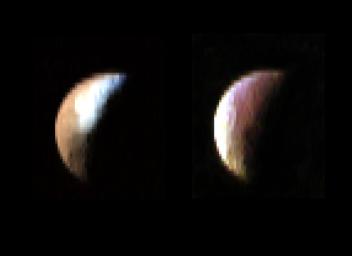
|
VIMS Iapetus Two Shooter
- Click the image above for a larger view
- Full-Res JPEG (1650 x 1200) (54.2 kB)
- Full-Res TIFF (1650 x 1200) (1.4 MB)
Caption:
These two color composite images of Saturn's moon Iapetus from Cassini's visual and infrared mapping spectrometer were obtained on Dec. 31, 2004, an hour and a half before the New Year, at a distance of 121,000 kilometers (75,186 miles), with a spatial resolution of about 60 kilometers (37 miles).
The three colors used in the left mosaic correspond to 1.01, 1.51, and 2 microns, while the right mosaic is comprised of images at 3.0, 3.21, and 4.60 microns. The two images show the vast difference in the composition of the bright and dark regions of Iapetus. As one moves from the near infrared 1 to 2 micron spectral region (left image) to the 3 to 5 micron spectral region (right image) the bright, ice-rich region on Iapetus turns dark and the dark region rich in organics turns bright.
Background Info:
The Cassini-Huygens mission is a cooperative project of NASA, the European Space Agency and the Italian Space Agency. The Jet Propulsion Laboratory, a division of the California Institute of Technology in Pasadena, manages the mission for NASA's Science Mission Directorate, Washington, D.C. The Cassini orbiter and its two onboard cameras were designed, developed and assembled at JPL. The visible and infrared mapping spectrometer team is based at the University of Arizona, Tucson.
For more information about the Cassini-Huygens mission visit, http://saturn.jpl.nasa.gov . For more information about the visual and infrared mapping spectrometer visit http://wwwvims.lpl.arizona.edu/ .
Cataloging Keywords:
| Name | Value | Additional Values |
|---|---|---|
| Target | Iapetus | |
| System | Saturn | |
| Target Type | Satellite | |
| Mission | Cassini-Huygens | |
| Instrument Host | Cassini Orbiter | |
| Host Type | Orbiter | |
| Instrument | Visual and Infrared Mapping Spectrometer (VIMS) | |
| Detector | ||
| Extra Keywords | Color, Infrared, Visual | |
| Acquisition Date | ||
| Release Date | 2005-01-10 | |
| Date in Caption | 2004-12-31 | |
| Image Credit | NASA/JPL/University of Arizona | |
| Source | photojournal.jpl.nasa.gov/catalog/PIA07000 | |
| Identifier | PIA07000 | |
